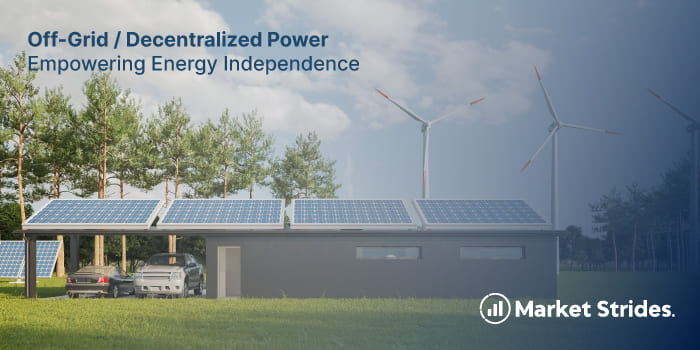Off-Grid / Decentralized Power: Empowering Energy Independence

Introduction
As the global energy landscape rapidly evolves, the need for sustainable, resilient, and accessible power solutions is more crucial than ever. Among the most transformative trends is the shift from traditional centralized electricity systems to off-grid and decentralized power solutions. These systems are redefining how energy is generated, distributed, and consumed particularly in remote, underserved, or disaster-prone regions.
What is Off-Grid / Decentralized Power?
Off-grid power refers to systems that operate independently of a centralized electricity grid. These systems typically use renewable energy sources such as solar, wind, or micro-hydro, often paired with battery storage, to supply electricity directly to homes, businesses, or communities.
Decentralized power, on the other hand, involves smaller-scale energy production units that may or may not be connected to the central grid. These include rooftop solar panels, biomass generators, and community mini-grids, which allow for localized energy generation and management.
Key Components of Off-Grid and Decentralized Systems
-
Energy Generation Sources
-
Solar panels, wind turbines, small hydro systems
-
Biomass or diesel generators (for hybrid models)
-
-
Energy Storage
-
Lithium-ion or lead-acid batteries to store excess power for use during non-productive hours
-
-
Inverters and Controllers
-
Convert DC to AC power and manage load balance and system efficiency
-
-
Smart Meters & IoT Integration
-
Monitor usage, forecast demand, and improve reliability
-
Benefits of Off-Grid / Decentralized Power
1. Energy Access in Remote Areas
Off-grid solutions provide power where extending the grid is economically or logistically unfeasible such as rural villages, islands, or mountainous regions.
2. Resilience and Reliability
Decentralized systems are less vulnerable to large-scale failures. In the event of grid outages, these systems can continue to operate independently.
3. Environmental Sustainability
By leveraging renewable resources, off-grid systems reduce greenhouse gas emissions and promote cleaner energy alternatives.
4. Cost Savings Over Time
Although initial setup costs may be high, off-grid systems often lead to long-term savings on electricity bills and reduced fuel dependency.
5. Energy Autonomy
Communities and individuals gain control over their energy production and consumption, enhancing self-sufficiency and independence.
Applications Across Sectors
-
Residential: Rural homes, eco-friendly housing, vacation cabins
-
Commercial: Telecom towers, off-grid resorts, farms
-
Community: Village electrification, health clinics, schools
-
Disaster Relief: Emergency shelters, mobile clinics, field operations
Challenges to Overcome
-
High Upfront Costs: Solar panels, batteries, and infrastructure require significant capital investment.
-
Maintenance and Technical Skills: Remote areas may lack the expertise needed for upkeep.
-
Policy and Financing Gaps: Lack of supportive regulation and limited access to financing hinder large-scale adoption.
Global Trends and Innovations
-
Pay-As-You-Go (PAYG) Solar Systems
-
Widely used in Africa and Asia to make solar energy affordable through micro-payments.
-
-
Blockchain for Energy Trading
-
Enables peer-to-peer energy exchange in microgrids, increasing flexibility and market participation.
-
-
Hybrid Systems
-
Combining solar with diesel or other energy sources to ensure consistent power delivery.
-
-
Government and NGO Initiatives
-
India’s Saubhagya Scheme, USAID’s Power Africa, and UNDP rural electrification projects are driving widespread adoption.
-
Conclusion
Off-grid and decentralized power solutions represent a paradigm shift in global energy systems. They empower communities with clean, reliable, and locally managed electricity, bridging the energy access gap while contributing to climate goals. As technology advances and costs decline, these solutions are set to play a central role in the future of global electrification.